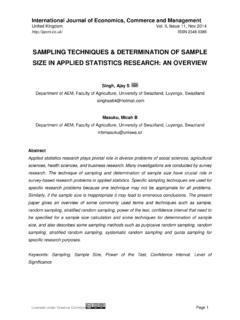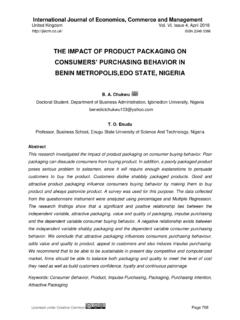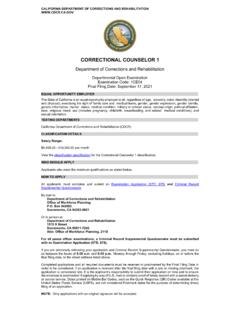Transcription of CORPORATE GOVERNANCE IN ZIMBABWE: THE ZIMCODE …
1 International Journal of Economics, Commerce and Management United Kingdom Vol. III, Issue 11, November 2015 Licensed under Creative Common Page 651 ISSN 2348 0386 CORPORATE GOVERNANCE IN ZIMBABWE: THE ZIMCODE AND STATE OWNED ENTERPRISES CONNECTION Chavunduka Muchineripi Desderio Chinhoyi University of Technology, Zimbabwe Sikwila Nyamazana Mike Chinhoyi University of Technology, Zimbabwe Abstract The Zimbabwe CORPORATE GOVERNANCE code ( ZIMCODE 2014) was introduced in April 2015 in an effort to incorporate CORPORATE GOVERNANCE in Zimbabwe and improve the performance of organizations. The purpose of this study is to examine the implementation of Zimbabwe CORPORATE GOVERNANCE code ( ZIMCODE ) by State Owned Enterprises (SOEs). A survey of SOEs was carried out in Harare and Bulawayo between October and December 2014 using a structured questionnaire .
2 A sample of 100 respondents of top and middle managers was used. Information obtained indicates that the SOEs do not have a model to use in the implementation of CORPORATE GOVERNANCE code . The authors develop a nested model that adds to the existing body of studies on the CORPORATE GOVERNANCE code . Keywords: ZIMCODE , public enterprise, organizational performance, CORPORATE GOVERNANCE INTRODUCTION CORPORATE GOVERNANCE is viewed worldwide in the business arena as, in part, incorporating transparency, fairness, independence, accountability, responsibility, integrity and social responsibility, among other things. These characteristics of CORPORATE GOVERNANCE form the basis of CORPORATE discipline of Best practices (Strenger, 2004) of any organization. CORPORATE GOVERNANCE has found its place in both developed and less developed economies as well as Chavunduka & Sikwila Licensed under Creative Common Page 652 emerging economies (Liu, 2006; Leech and Manjon, 2002).
3 Most countries that implement CORPORATE GOVERNANCE start by preparing a code that epitomises Best Practices (Cromme, 2005; Strenger, 2004; Fernandez-Rodriguez, et al., 2004; Akkermans, et al., 2007 and Dedman, 2002) and an adherence to code was then measured using various models such as scorecard and market-based models, among others (Liu, 2006). Zimbabwe adopted its ZIMCODE in (2014) in an effort to follow the band-wagon of CORPORATE GOVERNANCE best practices. The authors for this study define Zimbabwe national code on CORPORATE GOVERNANCE ( ZIMCODE ) as the yardstick that guides companies in Zimbabwe to adhere to the code of Best Practice (Strenger, 2004) in organizational performance and its implementation of CORPORATE GOVERNANCE in Zimbabwe. The state owned enterprise is a form of an organization whose origin is the state.
4 Like private public enterprise where suppliers of finance are separate from managers that run the enterprise, so is the state owned enterprise. The state that provides the initial funding allows board of directors appointed by the state to run the enterprise. CORPORATE GOVERNANCE has long been adopted by the countries in developed economies in order to improve the performance of organizations. However this has not been the case in Zimbabwe s state owned enterprises (SOE). As has been previously mentioned, most countries that implement CORPORATE GOVERNANCE start by preparing a code of best practices on the basis of which the enterprises in the respective countries measure their performance with respect to CORPORATE GOVERNANCE . There are various approaches that have been developed and used by different countries to measure the implementation of CORPORATE GOVERNANCE .
5 For example, USA and UK use market-oriented model (Liu, 2006), Germany uses scorecard model (Sprenger, 2004), China employs control-based approach (Liu, 2006), and Spain uses power indices approach (Leech and Manjon, 2002), among others. CORPORATE GOVERNANCE and its implementation are expected to curtail or deal with company failures. Zimbabwe has experienced poor performance of state owned enterprises in the period between 1990 and 2015 (Sikwila, Chavunduka & Ndoda, 2015). The CORPORATE failure and/or dysfunctional nature of SOEs could be noticed in Zimbabwe Steel Company, Zimbabwe Railways, Cold Storage Commission, Agriculture Development Authority (ADA), among others. In fact, the company failures were more pronounced in the private sector in the financial and banking industry between 1994 and 2015.
6 The failed banks and financial institutions include: Trust Bank, Barbican Bank (2004), United Merchant Bank, Genesis Investment Bank, Capital Bank Corporation, Royal Bank, Zimbabwe Building Society, Renaissance Merchant Bank, Time Bank, First National Building Society, National Discount House (2004), Prudential Discount House (1998), CFX Universal Bank, Tetrad Investment Bank, Interfin Merchant Bank (2014), and more recently (2015) AfrAsia Bank (Kingdom Bank). Most of the company failures were, in International Journal of Economics, Commerce and Management, United Kingdom Licensed under Creative Common Page 653 part, a result of ills such as corruption, fraud, excessive remuneration for board of directors and poor management of resources by board of directors in SOE and private sector, among other things (Zvavahera and Ndoda, 2014; Iskander and Chamlou, 1999).
7 It is against this background that the current study attempts to improve the implementation of CORPORATE GOVERNANCE in SOE, thereby ameliorating poor performance. The problem is that the state owned enterprises (SOE) lack a model for use in implementation of ZIMCODE . The purpose of the study is to provide a theory and means to assist the public enterprises in Zimbabwe to implement the ZIMCODE . The objective is to develop a model for implementation of ZIMCODE by SOEs. The question that has not been answered is how should the state enterprises implement the ZIMCODE ? The importance of the study was that the model that is proposed is expected to assist SOEs to reduce corruption tendencies, and improve on use of public resources. The nested model developed is expected to enhance SOE performance, and thereby improve their contribution to national development.
8 The model is different from the existing models in that it embeds the ZIMCODE within the strategic plan. This approach makes it easy to implement the CORPORATE GOVERNANCE best practices in that all stakeholders are involved in implementation of the strategic plan. The paper is divided into five sections. Section one presents the introduction in which the contextual aspects of the study is explained. Section two gives the literature review. Section three presents the methodology while section four presents the results (Nested Model) and discussion. Finally section five gives the conclusion. LITERATURE REVIEW The theory of CORPORATE GOVERNANCE is premised on the link on one hand, between the owners of the resources that provide investment funds as well as take the risk and on the other the board of directors that provide stewardship of the organisation financial and physical assets.
9 CORPORATE GOVERNANCE ensures that the board of directors take appropriate decisions (Shleifer and Vishny, 1997) that ought to allow organizations to take into account the interest of key stakeholders. According to Sir Adrian Cadbury (1999): CORPORATE GOVERNANCE is concerned with holding the balance between economic and social goals and between individual and communal aim is to align as nearly as possible the interests of individuals, corporations and society. Sir Adrian Cadbury, CORPORATE GOVERNANCE Overview, 1999, World Bank Report. The definition by Sir Adrian Cadbury holds for the private and state owned enterprises. In a report by the World Bank (2014), state-owned enterprises are still the major players in the economic activities of their nations despite the trend toward privatization over the past 20 years.
10 For the foreseeable future, they will continue to deliver critical products and services. As in Chavunduka & Sikwila Licensed under Creative Common Page 654 many parts of the world, State enterprises the world over are under pressure to improve their performance so as to create greater value for their economies as well as reduce their fiscal dependence. In an attempt to achieve this expectation, the respective governments have to engage in efforts to reform and implement CORPORATE GOVERNANCE . This view is corroborated by Nevondwe, Odeku & Tshoose (2014) who report that the importance of GOVERNANCE to SOE has become very important since these organizations have tremendous impact on the economies in which they operate.











